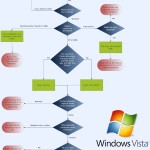There’re actually few options available instead of completely uninstall Windows Vista as listed below. But if you decide to downgrade from Windows Vista to install Windows XP, there is also a simple guideline that you can observe to ensure that the migration goes smoothly.
Option 1 – Dual Boot
It’s by far the easier and best method to run Windows XP instead of Windows Vista if you have another partition or hard disk. Simply boot up any Windows XP setup media and install Windows XP into different partition or hard drive than the Windows Vista installation. Once completed, you can choose to boot up either Windows XP or Windows Vista, and has the best of both world.
Option 2 – Virtual Machine
Install VMware Server or Virtual PC 2007 (both free) or any other virtualization software, and then install Windows XP into the virtual machine environment. You will get Windows XP which runs inside Windows Vista, with minor compromise on speed, performance and have to go through Windows Vista first on every bootup.
Option 3 – Format the Hard Drive, Wipe Off Windows Vista and Install Windows XP
For those who totally fed up with Windows Vista and just want Windows XP, or prefer a clean installation of OS has only this option to rely on. To downgrade to Windows XP from Windows Vista, you have to basically delete the whole hard disk that installed with Windows Vista, and start anew with Windows XP. Here’s a simple guide and procedures that you can try to follow to switch to Windows XP. However, each system configuration is different, so you may have to adapt the steps to suit your own need.
- Download all drivers for your system for Windows XP from the manufacturer’s website. Copy the drivers files to a USB flash driver or external hard drive or burn them to CD/DVD.
- Find a Windows XP installation CD. You can also use Volume Licensing (VL) CD, retail (FPP) disc, or system builder hologram CD provided by Microsoft.
- You will also need a XP product key even if you legally can downgrade from Windows Vista Ultimate or Business edition. The Windows Vista serial number won’t works with XP.
- Backup to USB flash disk, external portable hard disk or CD/DVD every data files and any other things such as documents, downloads, pictures, movies, programs and etc that you need and want to keep. You can also create a second partition with disk management utilities such as Acronis Director or Partition Magic, and then move the data files to the new partition.
- Ensure that also you have CD or DVD setup media for the software applications that you want to install and use after wiping off your system from Vista.
- If your OEM doesn’t provide you with recovery CD/DVD discs and Windows setup media discs (it’s because they’re stored in the hard disk in hidden location), you may want to burn a copy of recovery CD to CD/DVD first before you proceed, just in case the hidden partition is lost and you want to recover your computer to original state. (How-to Guide: IBM/Lenovo ThinkPad recovery CD)
- If the system has SATA (Serial ATA) hard drive, locate the driver for SATA controller and put it in USB flash drive, diskette or CD first. If you have PATA (normal IDE) hard disk, simply go to BIOS CMOS to disable SATA or Native SATA mode if you don’t want to install Windows XP on SATA hard drive. Else, you can also create an Windows XP install disc with the SATA drivers integrated by using tool such as nLite.
- In the BIOS, also set the CD or DVD optical drive as the first boot device in the boot sequence.
- Put in the Windows XP installation CD into CDROM drive and boot up the computer by using the CD. You probably need to press a key when prompted with “Press Any Key to Boot from CD…”.
- If you’re using SATA hard disk with driver on external media (not integrated into Windows XP setup disk), remember to press F6 when you see the message at the status base: “Press F6 if you need to install a third party SCSI or RAID driver…” during the very initial stage of setup to load the SATA driver so that the SATA hard disk can be recognized.
- Run through the setup wizard at per normal. However, when prompting for where to install Windows Vista, delete (by pressing D and then confirmation), create and format the Windows Vista disk drive or partition (if you have multiple partition). And then choose to install on that just formatted partition or hard drive.
IMPORTANT: If you choose the wrong hard disk or partition with data to delete, you will lose your essential data.
Note: If the setup does not allow you to delete or format the Windows Vista partition or drive, you will need to find a third party software that can recognize and read NTFS filesystem to clear the drive or partition first.
- Enter any product key for Windows XP. Windows Vista product key will not work.
- If you own a legitimate Windows Vista edition that allows for downgrade (See Windows Vista downgrade rights), call Microsoft after performing the clean install of Windows XP Pro to activate the Windows XP installation. Notify Microsoft that you’re downgrading from Windows Vista and require to activate Windows XP Professional or other version allowed newly installed. You won’t get a new Windows XP product key though. You will have to read out the long Installation ID plus your original Vista serial key, and Microsoft will provide an activation ID that will make the XP usable.
- Install the drivers for your system devices.
- Reinstall any software programs that you want to use.
- Move back the data files and documents.




